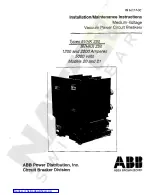
The demands regarding
communications
capability, data
transparency, flexibility
and integration in power
distribution systems are
increasing all the time.
The WL Circuit Breaker
is a modular circuit
breaker that fulfills the
requirements of the
future today.
Brief Description of the
WL Circuit Breaker
Circuit breakers today are
no longer simply devices
for protecting plants,
transformers, generators
and motors. Many users
now require a complete
overview of the plant from
a central control room and
round-the-clock access to
all available information.
Modern power distribution
systems are characterized
by the methods used to
network circuit breakers –
both with each other and
other components. The
circuit breakers in the
WL Circuit Breaker family
have a lot to offer:
It is possible to carry out
analysis and maintenance
procedures remotely via
the Internet. Operating
staff can be given
immediate access to
information on system
status and alarms. This
is not just a vision of the
future, but reality.
The WL Circuit Breaker,
covers the entire range
from 200A to 5000A.
The devices are available
with different interrupting
ratings, allowing short-
circuit currents of up to
2
00
kA to be interrupted
reliably.
WL Circuit Breakers can be
adapted to different system
conditions, which means
that a rating plug can be
used to adapt each circuit
breaker to the appropriate
rated current. This ensures
that optimum protection is
provided, even if changes
have been made in the
system. The modules
(reference Graphic 2-1)
can be replaced without the
need for the transformer
to be changed.
WL Circuit Breaker
Communication-capable Circuit Breakers
Introduction and Overview
2/1
Graphic 2-1
The system architecture of the WL Circuit Breaker with
Cubicle
BUS
enables simultaneous communication via PROFIBUS
and BDA with a laptop or Ethernet/Intranet/Internet.
Note: Installation instructions related to the communication modules
described in this section can be found in the individual instruction
sheets and/or Section 9 of the Operator's Manual
WL PROFIBUS Communication and Electronic Accessories • July 2004











































